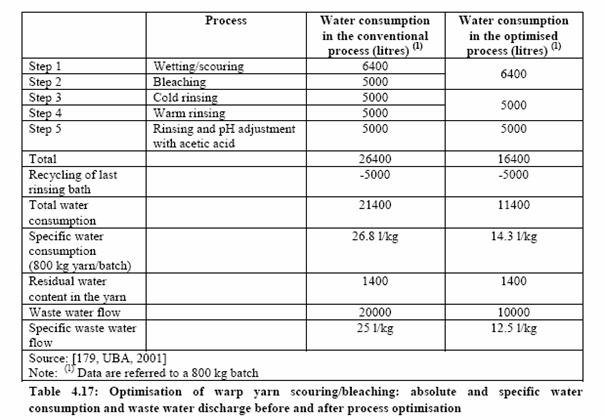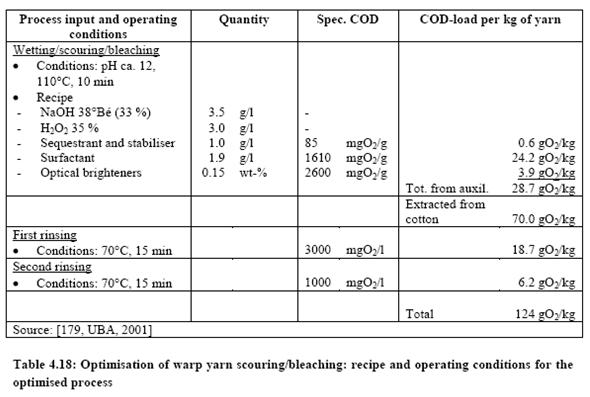Difference between revisions of "Scouring of cotton"
m (Protected "Scouring of cotton" [edit=autoconfirmed:move=autoconfirmed]) |
m (Changed protection level for "Scouring of cotton" ([edit=sysop] (indefinite) [move=sysop] (indefinite))) |
(No difference)
| |
Latest revision as of 11:23, 1 March 2013
Back to Scouring of cotton and bast fibres
1. DESCRIPTION OF TECHNIQUES, METHODS AND EQUIPMENT
- Typical Formulation for Scouring Cotton
The characteristic speckled look of cotton greige fabrics is caused by cotton motes that were not removed during the yarn making process. Mote removal is a major objective in scouring cotton. Another objective of scouring is to remove minerals, waxes and pectines and to improve absorbency. There are three components in a cotton scouring bath: caustic, to swell and dissolve the motes and to saponify oils and waxes, surfactant, to lower the bath's surface tension so it can wet-out the fabric faster and to emulsifies oils and waxes and chelating agent, to form water dispersible complexes with heavy metals.
- a. Batch Scouring Procedure
1. Run fabric in a bath containing :
2. Process fabric at 212°F in beck or jet for one hour. 3. Rinse thoroughly.
- b. Continuous Scouring Procedure
1. Saturate fabric with:
2. Steam fabric one hour at 212°F in J-box or steamer. 3. Rinse thoroughly at 1600F
Literature: Chemistry and Technology of Fabric preparation and finishing; Dr. Charles Tomasino, Department of Textile Engineering, Chemistry & Science, College of Textiles, North Carolina State University, Raleigh, North Carolina, 1992.
2. NEW TECHNOLOGIES
- a) Changes in the process
1.) One-step desizing, scouring and bleaching of cotton fabric
For cotton woven fabric and its blends with synthetic fibres, a three-stage pretreatment process has been the standard procedure for many years, comprising:
- desizing
- scouring
- bleaching
New auxiliaries’ formulations and automatic dosing and steamers allow the so-called “Flash Steam” procedure which telescopes desizing, alkaline cracking (scouring) and pad-steam peroxide bleaching into a single step.
- Main achieved environmental benefits
Combining three operations in one allows significant reductions in water and energy consumption.
- Operational data
Within the space of 2 – 4 minutes (with tight strand guidance throughout) loom-state goods are brought to a white suitable for dyeing. This is a big advantage, especially when processing fabric that is prone to creasing.
One of the possible consists of:
- 15 – 30 ml/kg phosphorus-free mixture of bleaching agents, dispersant, wetting agent and detergent
- 30 – 50 g/kg NaOH 100%
- 45 – 90 ml/kg H2O2 35 %
The sequence of the “Flash Steam peroxide bleach” is:
1. application of the bleaching solution
2. steam 2 – 4 min (saturated steam)
3. hot wash off
Scouring: BAT in textile industry, 2003
2.) Optimization of cotton warp yarn pretreatment (wetting/scouring, bleaching, rinsing)
In the production of white, non-dyed cotton sheets (e.g. sheets to be used under bed sheets and table-cloths) cotton warp yarn is bleached before weaving (for the production of this type of article the fabric does not need to be desized after the weaving process).
The conventional process consists of five steps, including wetting/scouring, alkaline peroxide bleaching and three subsequent rinsing steps. The last rinsing step is re-used for making the first bath. This process can be further improved by combining wetting, scouring and bleaching in one step and performing rinsing in two steps, re-using the second rinsing bath for making the bleaching/scouring bath (as above).
In addition, the energy consumption of the process has been reduced by heat recovery. The heat form the scouring/bleaching bath (110°C) is recovered (by means of a heat exchanger) and used for heating the fresh water for the first rinsing. The bath is therefore cooled to about 80°C, while the fresh water reaches a temperature of 60 – 70°C.
This cooled scouring/bleaching bath is collected in a tank together with the warm rinsing water from the first rinsing step. This water still has a valuable energy content. Therefore, before being drained, this stream is used to heat the water from the second rinsing step (which is then used for making the bleaching/scouring bath a explained above).
- Main environmental benefits
Water consumption and water discharge before and after optimization can be seen from the following table: 50% reduction of water consumption is achieved.
The consumption of chemicals and energy has also been reduced drastically. The following savings are achieved:
- process time …………………………… ………….about 50%
- water consumption/waste water discharge ……….. about 50 %
- energy ………………………………………………1.2 kg steam/kg warp yarn
- chemicals (see BAT for textile industry, 2003 – Sector 4)
- Operational data
The operating conditions of the optimized process are illustrated in Table 4.18, which also contains the calculation of COD-input and output.
- Recipe and operating conditions of the optimized process:
- b) Changes in the heat supply system
No information is available.
- c) Changes in the energy distribution system
No information is available.



